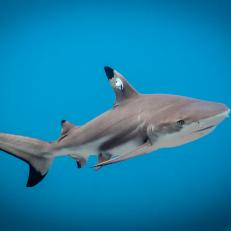Celebrate International Whale Shark Day with these Beautiful Giants
To commemorate International Whale Shark Day (August 30) we're introducing you to the whale sharks who call Georgia Aquarium home. Ocean Voyager, the 6.3 million gallon exhibit (yes, you read that right) houses two full-size whale sharks.
THE AQUARIUM, which ran for two seasons on Animal Planet (2019-2020) and provided viewers with a behind-the-scenes look at Georgia Aquarium, is available in its entirety to stream on discovery+.
August 30, 2021
View The Gallery
1 / 9
International Whale Shark Day is August 30! They are the largest fish in the world and the largest fish known to have lived on this planet. The largest accurately measured whale shark was 61.7 feet (18.8 m).
Georgia Aquarium has two whale sharks in their Ocean Voyager habitat, Yushan and Taroko, both are males.
Whale Sharks are listed as Endangered on the IUCN Red List. Specific threats to whale sharks include entanglement in fishing nets, boat strikes, ingestion of marine debris and micro plastics, and in some cases human interference through unregulated tourism.
Whale sharks are usually found in the tropical Atlantic, Pacific, and Indian Oceans between about 30 degrees North and 35 degrees South.
Georgia Aquarium has been researching whale sharks for more than 15 years. Their researchers have studied whale shark migration, overall health, and more in places like Mexico, St. Helena Island, Indonesia, and the Galapagos! Having whale sharks in the daily care of Georgia Aquarium has helped them study this species much more in depth than in the wild.
Whale sharks may look intimidating due to their size, but they can only swallow small prey because its throat is very narrow, often compared to the size of a quarter.
Whale sharks filter food from the water by “cross-flow filtration,” this means water is directed away through the gills while particles carry on towards the back of the mouth.
Whale sharks have multiple feeding methods: active suction feeding and vertical suction feeding. At Georgia Aquarium whale sharks are fed in the active suction-type feeding style, while following feeding ladles along the surface. The top jaw typically breaks the surface creating a strong suction and bringing in large volumes of water.
Whale sharks usually swim at a speed of 2.9 mph. When alarmed, they have been observed to accelerate for very short bursts, but they cannot sustain fast swimming for long.
























